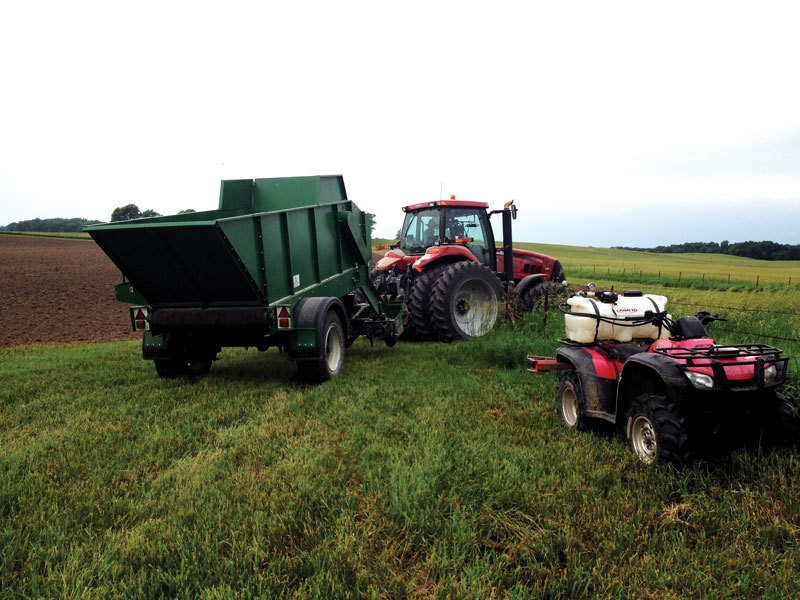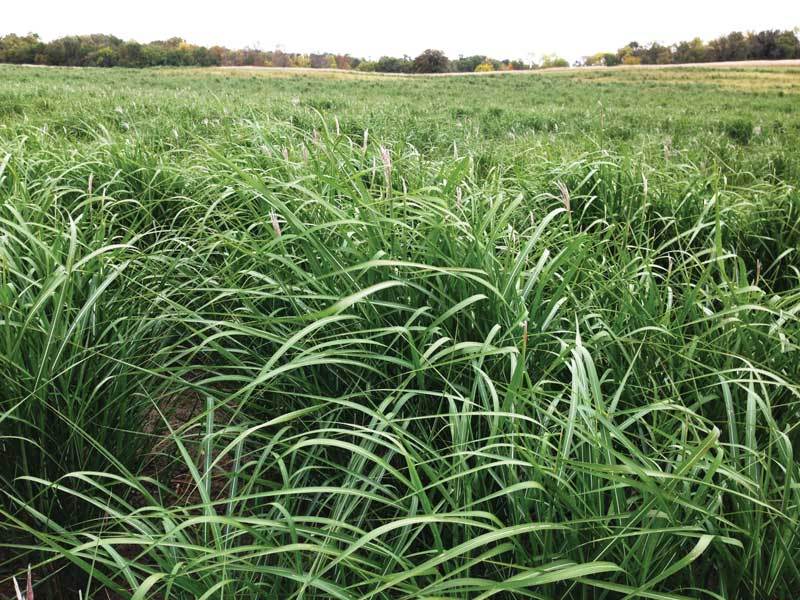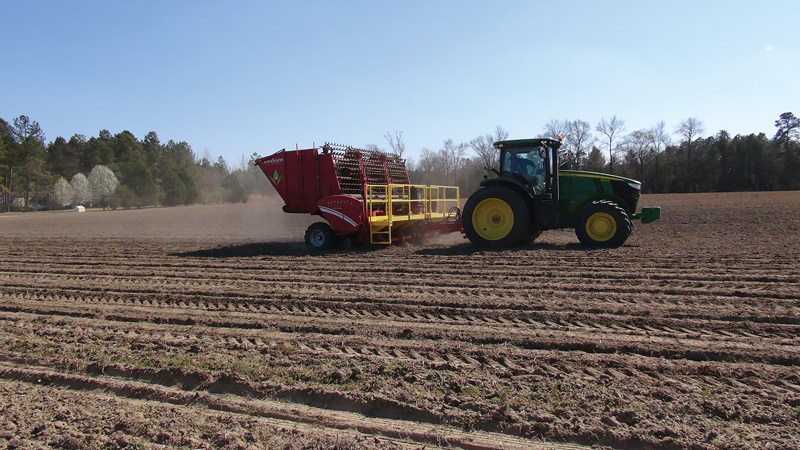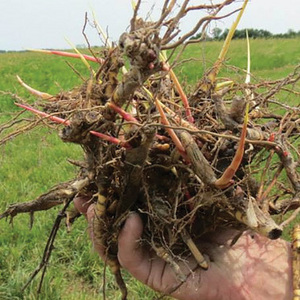Masterminding Miscanthus













PHOTO: Ferman Milster
January 25, 2014
BY Anna Simet
A sterile hybrid, warm-season grass native to Asia, giant miscanthus is known for its high yields—up to 15 tons of dry matter per acre—and its ability to grow in cool temperatures on marginal land. It has been extensively researched in Europe since the early 1980s, and today the crop is commonly used there for energy. In contrast, the miscanthus market is just beyond its infancy in the U.S., but researchers and companies are making steady advancements to provide farmers with the tools and knowledge they need to grow the crop on a commercial scale.
Plugs vs Rhizomes
Similar to switchgrass, giant miscanthus uses soil nutrients very efficiently, as most of the nutrients used to produce stems and leaves are recycled back down to the plant’s rhizome system after the growing season for use in subsequent crops. Rhizomes—horizontal-growing roots—can be used for propagation by dividing the root and replanting to grow new stands, one of two methods for establishment. The other means is through of live plants, or plugs, and both methods demonstrate advantages and disadvantages over the other. “Both [methods] are fine for bioenergy, but the big difference is the cost of each type of propagation,” says Tom Voigt, feedstock production and agronomy program leader at the University of Illinois’ Energy Biosciences Institute. “We’ve propagated using both methods, but for the last several years we’ve been using plugs. We tend to have fewer skips with plugs than we do with rhizomes, and therefore have a more uniform field the first year, but the cost is much higher.”
That work—which includes plot establishment in multiple states including Illinois, Nebraska, Kentucky, New Jersey and Virginia—has been done with mechanical planters similar to tobacco setters or vegetable transplanters, Voigt says, and thus has been fairly labor intensive and expensive. “We’ve had good success with rhizomes though, provided they are in good shape and fresh, and there are mechanical planters out there that get a lot more acres done with a lot less labor. I don’t know that anybody’s developed a mechanical planter for plugs, but if there were one, that could reduce the labor involved.”
The cost of rhizomes is generally less than the cost of plugs, Voigt adds, but he reiterates that there are many more skips or holes in the field, due to nonsprouting rhizomes. “That’s not a big problem long-term, but if a farmer is accustomed to growing row crops where every seedling comes up and looks the same, using rhizomes might be a little off-putting, especially if they’re comparing it to corn or soybean seedlings where every plant pretty much looks the same as it emerges,” he says.
Rather than plugs, the University of Iowa has chosen rhizomes as its propagation method, and has established its first of several miscanthus plots to use as one of several cofired coal replacements to help meet the university’s goal of 40 percent renewable energy by 2020. The work UI is doing has garnered a lot of interest, according to Ferman Milster, principle engineer of renewables, which began with the planting of 16 acres of miscanthus last June.
Digging In
“We picked miscanthus because of its relatively high yields of dry-matter tons per acre, its proven track record in Europe, and the knowledge and expertise we have here in miscanthus agronomy,” Milster says.
UI purchased rhizomes from Leamington, Ontario-based New Energy Farms, which were lifted in April from a farm in Georgia where they are grown for propagation. The rhizomes were cleaned, transferred into two super sacks and transported to the university, where they were kept in a refrigerated trailer, Milster says. “We wanted to get them in the ground mid-May or so, but it would not quit raining, so the rhizomes—about 15,000 per sack—sat in the trailer for six weeks.”
Periodically watering the rhizomes kept them in optimum condition. When the sacks were opened, some had sprouted, but overall were in very good shape, according to Milster. “As long as you keep that material cool and wet, they’ll store okay,” he says. June 22 ended up being planting day, and a NEF-supplied, European rhizome planter was used.
On the planting process, Milster admits that it was time-consuming, mainly because it was the first time the contracted farmer had used the planter. “There was a learning curve calibrating the planter and figuring out how to use it,” he says. “It took almost all day to get the 16 acres planted, but once one has the experience behind him, he could probably easily plant 40 to 50 acres a day.”
Advertisement
Advertisement
The cost for the 16 acres topped out at about $2,000 an acre, but Milster says that’s twice the cost of what UI hopes to do in the future. “This is a pilot field, and we’re doing this to learn,” he says. “It’s going to allow us to experiment with different technologies, especially when it comes to harvest.”
The university is planning several larger plantings in the future, aiming for 1,000 acres in 2015 and 1,500 more in 2016. “It’s really the third year before you get into production yields,” Milster says, “so it’s a long-term investment for us. The university is willing to take the initial risk to establish the fields, but we have long-term contracts to own the crop for a significant period of time.”
Communication with the agricultural community is really important, Milster adds, and therefore the university has held several grower meetings to answer questions and concerns of interested farmers, while seeking to fill in all of the informational gaps surrounding the idea of miscanthus as a commercial energy crop. “We really can’t launch into [commercial] production until we understand more of the cost information, what works and what doesn’t, and be able to show it all to farmers and interested growers.”
Repreve Renewables LLC is one company that works directly with farmers to alleviate any concerns or doubt they may have when contemplating growing miscanthus, via a suite of services that includes appropriate machinery and connection with an end market.
Challenges and Education
Repreve Renewables currently has giant miscanthus rhizomes of its patented, sterile variety, Freedom, as well as public varieties for purchase. For the past three years, the company has been developing what it has dubbed Accu Yield, a proprietary system designed to achieve maximum yields and returns. “One of the biggest challenges [with giant miscanthus] has been propagating rhizomes on a commercial scale, and that’s what we’ve been able to master,” says CEO Jeff Wheeler. “Our method lifts rhizomes up [out of the ground] with our Accu Lifter, and then takes them through processors that clean, size and package them into bulk containers.” In addition to the rhizomes, the company offers a proprietary precision planter to control the number of plants per acre.
On crop management, Wheeler says miscanthus is very easy to manage, and can provide good returns on marginal and underutilized land that isn’t growing food crops today. “It doesn’t require a lot of [grower’s]time, and it can provide a consistent and more predictable return.”
Aside from those assurances and miscanthus’ other favorable characteristics, there are still challenges with and questions about the crop. “The biggest is determining what the downstream market is,” Wheeler says. “Farmers want to make sure they have an avenue to sell it. We try to take all of the doubts and concerns away from farmers by working with them on a case-by-case basis to make sure they get a return off the land so there’s no fear of going into the unknown of planting a new crop.”
Another issue is growers adjusting to the crop and how it is managed. “Farmers usually think on an annual basis and make decisions based on just one year,” Wheeler says. “This is a perennial crop, so a stand can last over 15 years. It is much different than what farmers are typically dealing with for the majority of crops they plant today.”
Voigt says the University of Illinois’ oldest stand was planted in 1988 and is still very productive. “We’ve actually propagated many acres from it. It can be very long-lived, I’d be very surprised if a farmer didn’t get 12 to 15 years out of a planting of it.”
Advertisement
Advertisement
Miscanthus’ productivity and consequent unique harvesting requirements are different from what many farmers have ever experienced. “We’ve had success with a variety of forage harvesters and mowers, conditioners and balers, but generally it’s a slower process than a hay crop or even switchgrass,” Voigt says. “It’s not really a challenge, but a farmer may have to harvest slower than they’d like to.”
Wheeler notes that Repreve is developing new markets that don’t need government support, but he says there are new markets that require government support to attract investments. "BCAP is one program that is critical to developing new markets," he says. "The key to BCAP working is stability, and that is what we are working on with policymakers."
Miscanthus may come in handy for Iowan farmers combating soil erosion and mitigating nutrient management issues that the state currently faces. “There’s a general awareness throughout Iowa that there are severe soil erosion and nutrient management issues—it’s a huge deal—and dedicated, perennial energy crops are one way to help mitigate those issues,” Ferman says. “It’s an exciting way, a way agriculture can generate new revenue streams not dependent on corn and bean production.”
Ferman adds that UI and others doing similar work are creating a market where one does not exist. “That’s been the significant barrier to energy crop production…we’re working on establishing a significant market, and hopefully others will take interest and see that it’s growing.”
Author: Anna Simet
Managing Editor, Biomass Magazine
asimet@bbiinternational.com
701-738-4961
Upcoming Events





